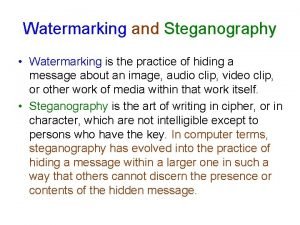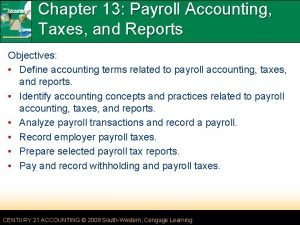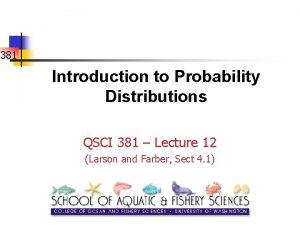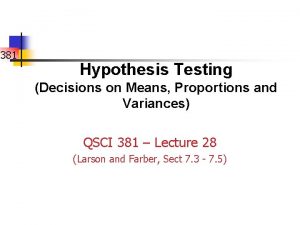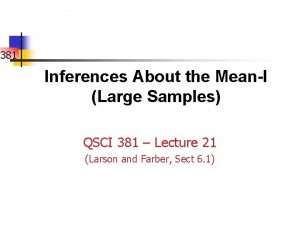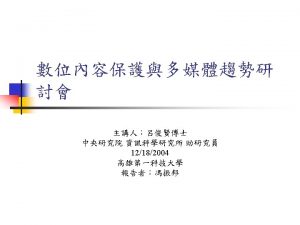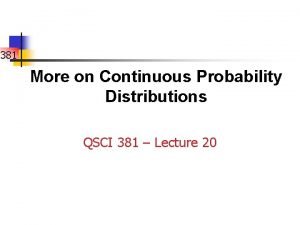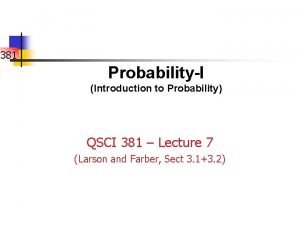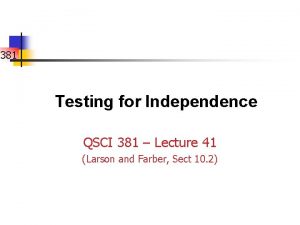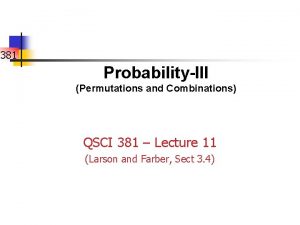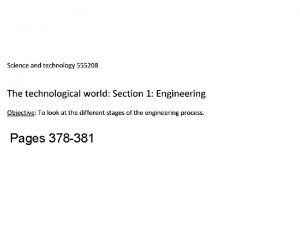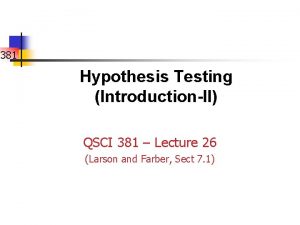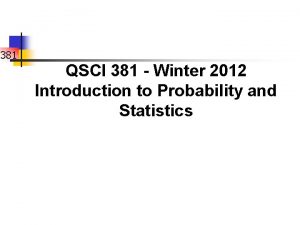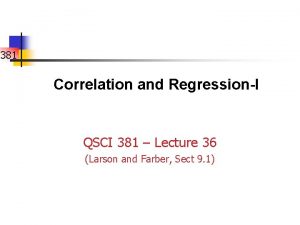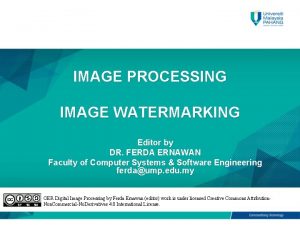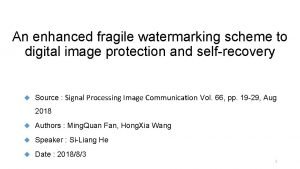Digital Image Watermarking ErHsien Fu EE 381 K15280










![Convolutional Codes C 0 Input=[. . . 101101010110000] G 0 = [1 1 0 Convolutional Codes C 0 Input=[. . . 101101010110000] G 0 = [1 1 0](https://slidetodoc.com/presentation_image/5339d2b628a81b7b67f834923fa02ad6/image-11.jpg)






- Slides: 17

Digital Image Watermarking Er-Hsien Fu EE 381 K-15280 Student Presentation

Overview • Introduction • Background Watermark Properties Embedding Detection • The Project Introduction Embedding Detection • Conclusions

Introduction • Watermark--an invisible signature embedded inside an image to show authenticity or proof of ownership • Discourage unauthorized copying and distribution of images over the internet • Ensure a digital picture has not been altered • Software can be used to search for a specific watermark

Background Watermark Properties • Watermark should appear random, noise-like sequence • Appear Undetectable • Good Correlation Properties High correlation with signals similar to watermark Low correlation with other watermarks or random noise • Common sequences A) Normal distribution B) m-sequences W=[1 0 011010 01111 0 0 0]

Project: Introduction • Possible for watermark to be binary sequence • Error-correction coding techniques • Use convolutional codes • Decode by Viterbi algorithm • Compare with non-coding method • See if it improves watermark detection • More or less robust to attacks? Additive noise, JPEG Compression, Rescale, Unzign • Performance assessed by correlation coefficient

Watermark Embedding Watermark Original Image Watermarked image • Watermark placed into information content of Original Image to create Watermarked Image • Image Content Spatial Domain (Least Significant Bit) FFT - Magnitude and Phase Wavelet Transforms DCT Coefficients

Setup-Watermark Embedding Image Watermark DCT 1000 Highest Coeff Conv Code IDCT Watermarked Image Interleave • DC Component Excluded for 1000 Highest Coefficients • Interleaving prevents burst errors • Watermarked Image Similar to original image • Without coding, ignore Conv Code and Interleave block

Original Image Watermarked Image, No Coding • 512 x 512 “Mandrill” Image • See Handout • Both watermarks imperceptible • Alterations to original image difficult to notice Watermarked Image with Coding

Watermark Detection = * Suspected Image Extracted Watermark Original Watermark Correlation • Watermark Extracted from Suspected Image • Compute correlation of Extracted and Original Watermark • Threshold correlation to determine watermark existence

Watermark Detection W 2 Corrupted Image Deinterleave, Viterbi Decode Extracted Watermark W 1 Original Image 1000 Highest DCT Coeff Owner’s watermark • For no coding, deinterleave and decode block ignored • =E[W 1*W 2]/{ E[W 12]E[W 22]} • If W 1=W 2 then =1 • if W 1 and W 2 are independent, then =0 if E[W 1]=0 • Corruptions are additive noise, JPEG Compression Image scaling, and Un. Zign Correlation Coefficient
![Convolutional Codes C 0 Input 101101010110000 G 0 1 1 0 Convolutional Codes C 0 Input=[. . . 101101010110000] G 0 = [1 1 0](https://slidetodoc.com/presentation_image/5339d2b628a81b7b67f834923fa02ad6/image-11.jpg)
Convolutional Codes C 0 Input=[. . . 101101010110000] G 0 = [1 1 0 1 1] G 1 = [1 0 1 1 1 0 0 0 1] C 1 • Output C 0 = conv(G 0, Input); Output C 1=conv(G 1, Input) • Convolutional code implemented using linear shift registers • Adds redundancy for error-correction • Encoding/Decoding well researched • Good coding performance, very popular

State 0 1 2 3 Viterbi Decoding … … • Find most likely path through trellis • Begin and end at all zero state • Upper arrows => input=0, Lower arrow =>input=1 • Every possible input/output combination is compared with the received output • Optimal Decoding Method

No Coding: Additive Noise(0, 900) With Coding: Additive Noise (0, 900) • Zero mean additive noise, variance=100, 400, 900 • Both methods had high correlation • Coding method performed slightly better • For variance = 900 (no coding) = 77% p (coding) = 84%

4: 1 JPEG Compression, No coding 4: 1 JPEG Compression With Coding • JPEG Compression: 1. 4: 1, 2. 2: 1, 4: 1 ratio • Both methods resistant to JPEG compression • Coding method outperformed non-coding method • Perfect detection for coding method

Watermark removal using Unzign Convert to grayscale and resize • Unzign--watermark removal software • Image resized to 512 x 512 and convert to grayscale before detection • Moderate detection for without coding: (no coding) = 57% (coding) = 23% • Coding method sensitive to resizing

Conclusions • Convolutional coding more immune to additive noise and JPEG Compression • Coding method fragile w. r. t. rescaled images • Moderate detection levels for unzigned images • Further Suggestion: Try block DCT Use Wavelet Transform Exploit Human Visual System

Questions
 Difference between steganography and watermarking
Difference between steganography and watermarking Translate
Translate Linear position invariant degradation
Linear position invariant degradation Arithmetic coding in digital image processing
Arithmetic coding in digital image processing Image segmentation in digital image processing
Image segmentation in digital image processing Analog image and digital image
Analog image and digital image Fidelity criteria in digital image processing
Fidelity criteria in digital image processing Image sharpening in digital image processing
Image sharpening in digital image processing Geometric transformation in digital image processing
Geometric transformation in digital image processing Isopreference curve
Isopreference curve Walsh transform in digital image processing
Walsh transform in digital image processing Image geometry in digital image processing
Image geometry in digital image processing Image restoration in digital image processing
Image restoration in digital image processing 13-1 work together p. 381
13-1 work together p. 381 1. 13-1 work together, p. 381
1. 13-1 work together, p. 381 381 meaning
381 meaning Meaning 381
Meaning 381 381 meaning
381 meaning
